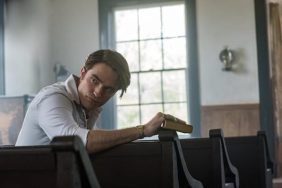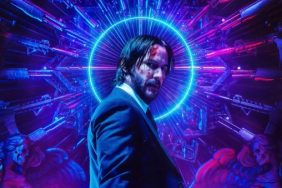Stop what you’re doing. Yes, you. Stop it. Put the internet down and rent, stream or watch the movie Exotica as soon as you can. Then come back. Pretty amazing, right?
Director Atom Egoyan has brought stories of people inexplicably joined through tragedy before, and got a few Oscar-nominations in the process for writing and director The Sweet Hereafter. But both The Sweet Hereafter and Exotica (a film that changed my life) were works of fiction. His latest look at a community torn asunder, Devil’s Knot, is a fictional dramatization of the real-life story of The West Memphis Three: a trio of heavy metal-loving teenagers who were accused and, as near as anyone can tell, falsely convicted of murdering three younger boys in 1994. Their story is well-known, documented in several acclaimed documentaries including West of Memphis and Paradise Lost: The Child Murders at Robin Hood Hills.
What could Atom Egoyan bring to the story that reality and investigative reporting hasn’t so far? That was the question on my mind as I interviewed the filmmaker over the phone, before segueing into his theory about why the “Satanic Panic” zeitgeist overtook Western Culture in the late 1980s and early 1990s.
Devil’s Knot, starring Reese Witherspoon, Colin Firth, Alessandro Nivola, Kevin Durant, Dane DeHaan and Stephen Moyer, arrives in theaters on May 9, 2014.
CraveOnline: I was watching Devil’s Knot and I was thinking about Exotica and The Sweet Hereafter. You seem to have a real affinity for the way that tragedy affects people in a community. Are you attracted to that?
Atom Egoyan: I think it’s sort of in the way I was raised. I’m Armenian, and so from a very young age I was always hearing stories about tragedy because of the genocide, and my grandparents were orphaned by this historic calamity. You’re just aware that lives can be dramatically taken into a territory that you would never have expected, and reeling from that, dealing with that, understanding how trauma rippled through generations and through lives in unexpected ways… That’s just been a part of my storytelling, I think, for a long time because it’s been so ingrained into my DNA. So yeah, these types of stories… when I look at this new film [The Captive] that we’re going to be premiering at Cannes in a couple of weeks and that’s also sort of in that line, yeah, I think that must be where it comes from. Because it’s pretty marked. [Laughs.]
These movies have a narrative throughline but the ensemble nature of them must make them difficult to structure dramatically.
Well this one, unlike the others, took a long time to edit. It took a long time to find a shape because there was just so much material. I spent really a year in the editing room because I shot another film while we were editing and came back to it, and we were bound by what actually happened. Unlike a film like Exotica or Sweet Hereafter or most of my other films, which are fiction, this is based on actual facts and court transcripts and police interrogations and surveillance videos. So we couldn’t really distort that, and I was really adamant about making sure that we were keeping it to reality but yet find a shape and a way of addressing that that could be compelling, and immerse the viewer in what happened. Where for the person who knew nothing about the story, it would make sense in its crazy way. Because in fact it doesn’t make sense. In terms of what actually happened seems so improbably, and [yet] that’s what did occur.
And yet you do also have to deal with audience members who do know what happened and have perhaps seen the various documentaries.
Yes.
How does that affect your decisions about what to keep in the movie or what not to keep in the movie, or even where to end it? You don’t take it all the way to present day, you keep Devil’s Knot in the initial trial.
Yeah, because I don’t think we have a resolution. I think it’s still open. I think that, yes, there’s a story to be told about what happened to these young men in prison, and certainly there’s the story of what has happened to them recently, but that’s not within the parameters of this particular telling of the story. This to me [is] the stuff of urban mythology in a way. This can be told in a number of different ways. Our focus is on what happened in that town in West Memphis 20 years ago, and also these two characters – Pam Hobbs and Ron Lax – who began to raise questions, who began to look at this and for very different reasons began to question, and have doubt about what they’re seeing happening around them, who are troubled by it. That to me hadn’t been explored in the documentaries. The documentaries seem to have an agenda of saying “look at this person as a suspect, if attention had been focused on this individual then an answer would have been had.” I don’t think it’s as simple as that, really. I think that that could have been another witch hunt, for all we know.
But at the end of the movie you do have a few title scrawls that catch people up on what happened since, and you do place a lot of emphasis on the idea there was evidence to support the idea that the boys’ fathers might have had something to do with it.
They might have, but it’s not conclusive by any means. It can’t be conclusive. Yes, there was evidence, but it’s DNA evidence [that], again, might make sense. The DNA might be there because the boy lived in that house. It’s by no means conclusive. We’re just trying to present everything as it happened.
I’m really interested in what you said about the idea of there being an urban legend to all of this, the way the mystery overtakes the town.
Yeah.
The idea of Satan worship we see as the film progresses is something that the town had been concerned about, but you don’t introduce it at the beginning. It’s something they fall back on once the narrative begins.
Right.
Can you tell me about that decision. Did you ever think about trying to open with that? Why did the Satan worship become a plot point after the investigation begins?
Because in a way, to have started with that would just said it was a real concern. It would have been what Jerry Driver says, that it had been brewing for some while. But I don’t know if it was. I think that was actually kind of conjecture. I think there was this myth in the early 90s of “Satanic Panic” happening everywhere. It happened up here in Canada, certainly. There was an incredible case here, not dissimilar from this, where suddenly everyone who worked at this nursery and the local police were all indicted in a kind of Satanic circle, and it all proved to be just completely bogus. It does raise questions about why that happened in the early 90s. I have my own theories about that, but I think it was all hyped up. As Ron Lax says, Colin Firth says to Jerry Driver [Elias Koteas], I launched an investigation into it and it was all smoke and mirrors. There was no real resurgence in Satanic activity, but certainly people began to perceive that, and that’s curious that it was focused in those years, really, from the late 80s to the mid-90s. I have my own theories as to why but I don’t want to stray too far from the conversation.
I think that’s actually relevant.
Yeah, I mean, do you want to go there?
Yes, I do. You’re telling the story, and I’m curious what your perspective is.
I just think that at that point, this was a time that suddenly families were not all crouching around a television, they aren’t watching shows together. This was a time when there were suddenly more channels, there was lots of other options for kids to find their own form of entertainment, and I think historically we’ll look back at that time as kind of a fracturing moment in what the family meant, in terms of how a family would watch things together, and so parents began to feel that some sort of custodial tradition was being broken, and that that would somehow transplant into a Satanic scare in nurseries and classrooms, that their children were somehow being exposed to the devil. I mean, it’s just one theory, but otherwise it’s really difficult to imagine why this was generated at that time.
William Bibbiani is the editor of CraveOnline’s Film Channel and the host of The B-Movies Podcast and The Blue Movies Podcast. Follow him on Twitter at @WilliamBibbiani.









